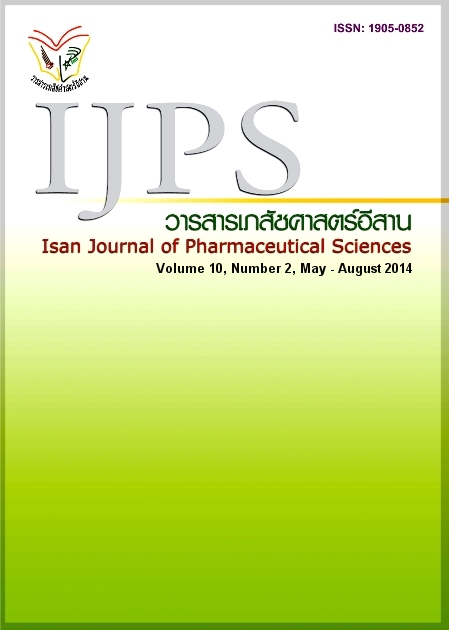Standardization of Thai Traditional Medicine Method for Treatment of Garcinia hanburuyi Hook.f Resins
Main Article Content
Abstract
Introduction: Garcinia hanburuyi Hook.f resin (GHR) is the exudate from G. hanburuyi stem (Clusiaceae) which is involved in various Thai traditional medicine recipes. The resin must have been treated with the specified techniques of Thai traditional medicine which are believed to reduce its toxicity or too strong activity before use. However, there has been no explanation about the properties of GHR after treatment. This study is therefore aimed to standardize of Thai traditional method for treatment of GHR. Materials and Method: The treatment of GHR was done by using the 7-layered wrapping with galanga leaves (Alpinia galanga (L.) Willd. ) or lotus leaves (Nelumbo nuclfera Gaertn) before grill and the new method of burning the aluminium foil wrapped GHR in the furnace. The HPLC chromatograms and amount of gambogic acid of GHR before and after treatments were analyzed. Results: The results showed that the optimal duration of grilling was until the sixth layer of galanga (approx. 35 min) or lotus leaves (approx. 25 min) were burned which led to the reduction of gambogic acid 30.09 % and 28.86 %, respectively. The new methods of aluminium foil wrapping when incubated at 120OC for 30 min and at 140 OC for 15 min showed the reduction of gambogic acid 29.17 %, and 29.24 %, respectively. The HPLC fingerprints of the new methods were found to similar as the traditional methods. Conclusion:The treatment processes of GHR decrease gambogic acid, a major active compound. The results are along with the Thai traditional medicine theory and could be used to explain why GHR activity could be reduced by Thai traditional treatments of GHR before uses.
Article Details
In the case that some parts are used by others The author must Confirm that obtaining permission to use some of the original authors. And must attach evidence That the permission has been included
References
Bobeyko VA, Kintia PK, Dranka IV. Thermal decomposition of furostanol glycosidetomatoside. J Therm Anal 1990; 36(4): 1307–17.
Chantarasriwong O, Batova A, Chavasiri W, Theodorakis EA. Chemistry and biology of the caged Garcinia xanthones. Chemistry 2010; 16(33): 9944–62.
David M, Culbreth R. A manual of materia medica and pharmacology. 6th ed. Philadelphia: Lea & Febiger; 1977.
Deng S, West BJ, Jensen CJ. Thermal degradation of fl avonol glycosides in noni leaves during roasting. J Food Sci Techno 2011; 3(2): 155–9.
He D, Xu Q, Yan M, et al. The NF-kappa B inhibitor, celastrol, could enhance the anti-cancer effect of gambogic acid on oral squamous cell carcinoma. BMC Cancer 2009; 9: 343.
Leszczyński PJ, Budzianowski A, Dobrzycki L, Cyrański MK, Derzsi M, Grochala W. Thermal and chemical decomposition of di(pyrazine)silver(II) peroxydisulfate and unusual crystal structure of a Ag(I) by-product. Dalton Trans 2012; 41(2): 396–402.
Norkaew P. Anti-infl ammatory, Analgesic and Antipyretic Activities of gambogic extract from Garcinia hanburyi Hook. F. Ph.D. Thesis, Chiangmai University; 2003.
Nualkaew S, Gritsanapan W, Petereit F, Nahrstedt A. New fatty acid esters originate during storage by the interaction of components in Prasaplai, a Thai traditional medicine. Planta Med 70; 2004:1243-1246.
Orwa C, Mutua A, Kindt R, Jamnadass R, Anthony S. Garcinia hanburyi Hook.f. Guttiferae. Agroforestry Database 4.0. Kenya: World Agroforestry Centre; 2009. 1–5.
Pithayanukul P. Beautiful discerning: How to get the health benefi ts of tea. Chaladsue Magazine 2010; 16(98): 56–7.
Qin Y, Meng L, Hu C. Gambogic acid inhibits the catalytic activity of human topoisomerase IIalpha by binding to its ATPase domain. Mol Cancer Ther 2007; 6(9): 2429–40.
Sathaban Phasa Thai. Phaetsat songkhro: phumpanya thang kanphaet lae moradok thang wannakam khong chat. Krung Thep: Sathaban Phasa Thai; 1999.
Sukpondma Y, Rukachaisirikul V, Phongpaichit S. Antibacterial caged-tetraprenylated xanthones from the fruits of Garcinia hanburyi. Chem Pharm Bull 2005; 53(7): 850–2.
Tao SJ, Guan SH, Wang W, et al. Cytotoxic polyprenylated xanthones from the resin of Garcinia hanburyi. J Nat Prod 2009; 72(1): 117–124.
Thamawech W. Rattanakosin pharmacy text book. 2nd ed. Bangkok : Silpa Siam Packaging & Printing; 2004.
Wang L, Li Z, Song D, et al. Two novel triterpenoids with antiproliferative and apoptotic activities in human leukemia cells isolated from the resin of Garcinia hanburyi. Planta Med 2008; 74(14): 1735–1740.
Wang X, Lu N, Yang Q et al. Spectacular modification of gambogic acid on microwave irradiation in methanol: Isolation and structure identifi cation of two products with potent anti-tumor activity. Bioorg Med Chem Lett 2010; 20: 2438-42.
Wattanawongdon W, Hahnvajanawong C, Anantachoke N et al. Antagonistic growth inhibitory effect of isomorellinol with chemotherapeutic agents against human cholangiocarcinoma KKU-M156 Cell Line. Srinagarind Med JP 2010; 265–268.
Wichayawiwattana P. Effect of heated-Trigonostemon reidioides extracts on antioxidation, antityrosinase activities and cytotoxicity against in L929 Cell Line. Bachelor Thesis, Mahasarakham University; 2011.


